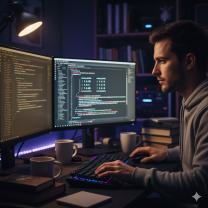Can you explain inverse variation?
Certainly! In mathematics, inverse variation is a type of relationship between two variables in which one variable increases as the other decreases, and vice versa, while their product remains constant. Inverse variation is also referred to as inverse proportionality. This means that as one variable gets larger, the other gets smaller in such a way that the multiplication (product) of the two variables stays the same.
Inverse variation can be described mathematically using the following equation:
In this equation:
- and are the two variables involved.
- is a constant (often referred to as the constant of variation) that remains the same for all pairs of values of and in the given inverse variation.
Here are some key characteristics and properties of inverse variation:
Product Remains Constant: The central idea of inverse variation is that the product of the two variables, , is always equal to the same constant value for all values of and in the relationship.
Inverse Relationship: Inverse variation implies an inverse or reciprocal relationship between the two variables. When one variable increases, the other decreases, and when one variable decreases, the other increases.
Graphical Representation: The graph of an inverse variation equation is typically a hyperbola. It consists of two branches that get closer to the coordinate axes but never touch them. The branches move closer to the axes as the values of and increase or decrease.
Constant of Variation : The value of is determined by the initial conditions and the specific relationship between the variables. It reflects how the variables are inversely related. As long as remains constant, the inverse variation holds true.
Examples of inverse variation in real-life scenarios include:
- The relationship between the time it takes to complete a task and the number of workers assigned to the task. As the number of workers increases, the time required decreases, and vice versa.
- The relationship between the force of attraction between two objects and the square of the distance between them, as described by Newton's law of universal gravitation.
- The relationship between the speed of a moving object and the time it takes to cover a fixed distance. As the speed increases, the time required to cover the distance decreases, and vice versa.
Inverse variation is a fundamental concept in mathematics and is used to describe various real-world phenomena where one quantity changes inversely with respect to another quantity while maintaining a constant product.
Demystifying Inverse Variation: A Comprehensive Explanation
Inverse variation is a mathematical relationship between two variables where one variable increases as the other variable decreases. It is the opposite of direct variation, where one variable increases as the other variable increases.
Understanding the Relationship Between Inverse Variables
Inverse variation can be represented by the following equation:
xy = k
where x and y are the two variables and k is a constant. This equation means that the product of the two variables is always equal to the constant.
For example, if the two variables are distance and time, and the constant is speed, then the equation xy = k means that the product of distance and time is always equal to speed. This is because the faster you travel, the less time it takes to cover a certain distance.
Another example of inverse variation is the relationship between the price of a good and the quantity of the good demanded. The higher the price of a good, the lower the quantity of the good demanded, and vice versa. This is because consumers are less likely to buy a good if it is expensive.
Practical Applications of Inverse Variation Concepts
Inverse variation has a number of practical applications in the real world. For example, it can be used to:
- Calculate the speed of a moving object
- Determine the time it takes to complete a task
- Predict the price of a good
- Design engineering systems
Here are some specific examples of how inverse variation is used in the real world:
- Engineering: Inverse variation is used in engineering to design systems such as bridges and buildings. For example, the strength of a bridge is inversely proportional to the length of the bridge. This means that a longer bridge must be stronger than a shorter bridge in order to support the same weight.
- Economics: Inverse variation is used in economics to study the behavior of consumers and producers. For example, the demand for a good is inversely proportional to its price. This means that the higher the price of a good, the lower the demand for the good.
- Science: Inverse variation is used in science to study the relationships between different variables. For example, the force of gravity between two objects is inversely proportional to the square of the distance between the objects. This means that the farther apart two objects are, the weaker the force of gravity between them.
Inverse variation is a powerful mathematical concept that has a wide range of applications in the real world. By understanding inverse variation, you can gain a better understanding of how the world around you works.












